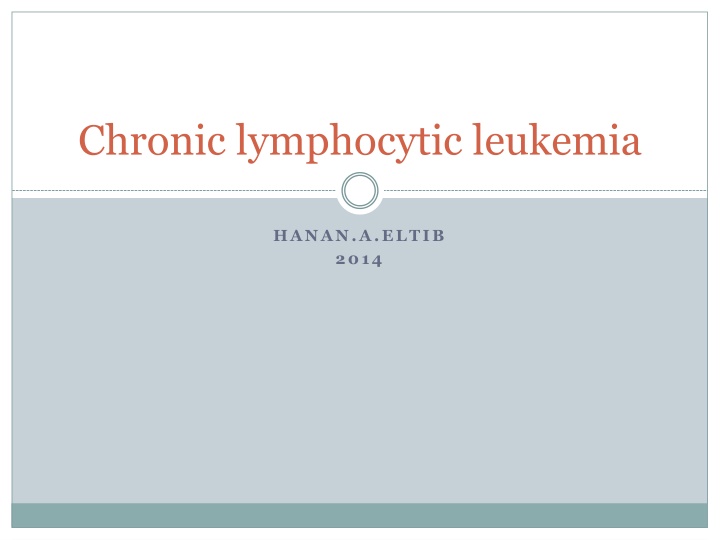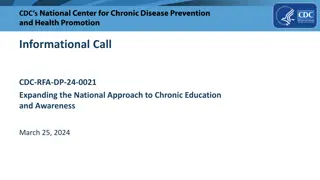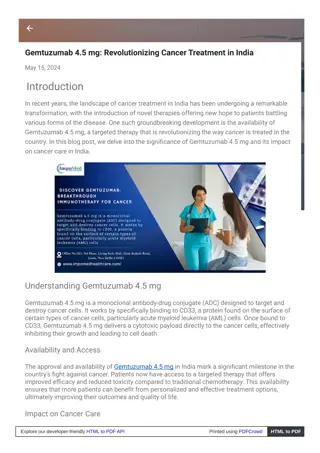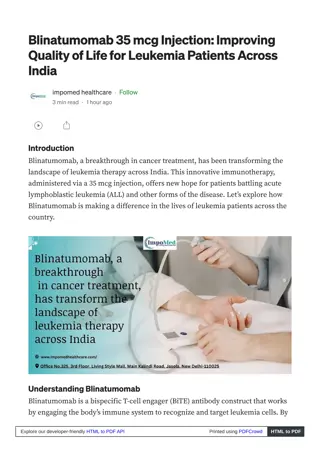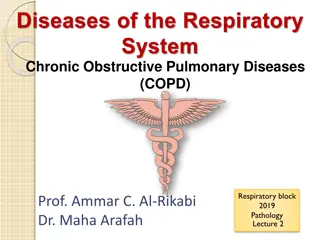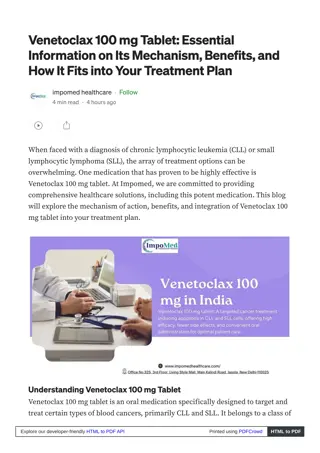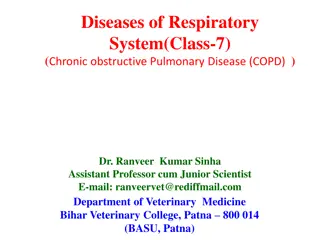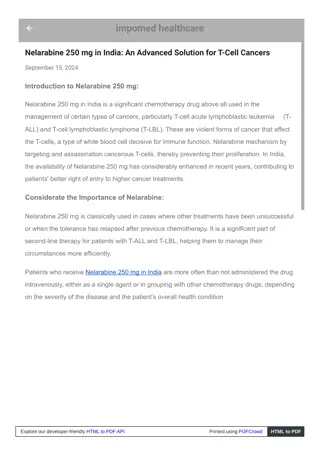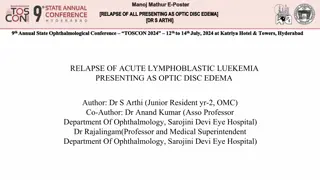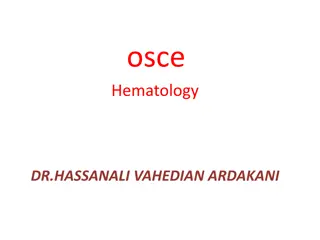Chronic lymphocytic leukemia
Chronic lymphocytic leukemia (CLL) is the most prevalent adult leukemia in Western countries, with a median diagnosis age of ~72 years. CLL is more common in men, and historically considered a disease of accumulation due to apoptosis defects. Diagnosis involves CBC and flow cytometry, with different management approaches for CLL and SLL. Initial work-up includes various tests such as FISH, LN biopsy, and molecular analysis for prognostic purposes.
Download Presentation

Please find below an Image/Link to download the presentation.
The content on the website is provided AS IS for your information and personal use only. It may not be sold, licensed, or shared on other websites without obtaining consent from the author.If you encounter any issues during the download, it is possible that the publisher has removed the file from their server.
You are allowed to download the files provided on this website for personal or commercial use, subject to the condition that they are used lawfully. All files are the property of their respective owners.
The content on the website is provided AS IS for your information and personal use only. It may not be sold, licensed, or shared on other websites without obtaining consent from the author.
E N D
Presentation Transcript
Chronic lymphocytic leukemia HANAN.A.ELTIB 2014
OVERVIEW The most prevalent type of adult leukemia in western countries Median age of diagnosis of CLL is ~ 72 years, with only 10% of patients younger than 50 years of age CLL morbidity rapidly increases with age More common in men than women (2:1 ratio)
Pathophysiology Historically CLL considered disease of accumulation due to defect in apoptosis CLL more proliferative disease than previously thought CLL cells up regulate gene signature consistent with BCR and NF-KB pathway activation
Diagnosis CBC: at least 5000 monoclonal B-lymphocytes/cml in the peripheral blood Morphologically :small mature lymphocytes N.B :Fewer clonal B-Cells LNS less 1.5 cm no anemia or thromocytopenia +/_ the immunophenotybe of the CLL ALymphoproliferative disorders :monoclonal B- lymphocytosis(MPL)
CLL/SLL Different managed in the same way The major difference SLL: the abnormal lymphocytes are predominantly found in the LNS-diagnosis mainly by LN biopsy-no more than 5000 clonal B-cells in the peripheral blood CLL: significant number of the abnormal lymphocytes are also found in the BM and blood manifestation of the same disease
Initial Work-up of CLL Patients Flow cytometry of the peripheral blood Kappa/lambda CD5 + CD19 + CD23 + CD10 - CD20 dim Surface IG dim Cycline D1 Atypical CLL : t(11;14) by FISH :LN biopsy with IHC CD3 CD5 CD10 CD20 CD23 Cyclin D1
Initial Work-up of CLL Patients Anemic pt : RC count - direct combs test LN biopsy only if diagnosis not confirmed by flowcytometry Bone marrow aspirate and biobsy not necessary in absence of cytopenias No CT scan unless symptoms are present; PET scan can be helpful if Richter s suspected Informative for prognostic and/or therapy determination flowcytometry or IHC: CD38-CD70 cytogenetics analysis : +12, del(13q), del(17p)and del(11q) mollecular analysis : IGVH gene status assessment-TP53 serum level : 2-microglobulin
Initial Work-up of CLL Patients Physical Exam LNs : size-symptoms liver-spleen size B-symptoms Performance Useful under certain circumstaces haptoglobin Serum QIG level uric acid LDH HBV
RAIs CLINICAL STAGING SYSTEM Stage Clinical Features at Diagnosis Median Survival (years) >12,5 0 Blood lymphocytosis>5000/mcl, Bone marrow lymphocytosis>30% Low risk I Intermediate risk Stage 0 and enlarged lymph node(s) 8 II Stage 0-I and enlarged spleen and/or liver 6 Intermediate risk III Stage0-II and anemia (Hb < 11g/dl) 1,5-2 High risk IV Stage0-III and thrombocytopenia(< 100 000 /mcl) 1,5-2 High risk
When to Treat CLL Patient No advantage to treating CLL until symptoms develop Constitutional symptoms due to disease (fatigue, B symptoms) Enlarging, symptomatic lymph nodes (> 10 cm) Enlarging, symptomatic spleen (> 6 cm BCM) Cytopenias due to CLL (hemoglobin < 11 g/dL, platelets < 100,000 cells/ L) Poorly controlled AIHA or ITP Absolute lymphocytic count alone is not indication for treatment unless above 200-300 109/L Or symptoms related to leukostasis
Treatment options Alkylating agents Purine anologue vs Alkylators Higher RR and PFS Better QOL Not OS Purine/alkylator combo vs. purine: Higher RR and PFS Not OS
Treatment options CLL8 study ;chemoimmunotherpy : FCR VS FC More neutropenia A better therapy for young physically fit pt Significantly improves ORR and CR Significantly improves PFS Significantly improves OS 7% Most genetic groups benefit from FCR therapy except for del(17p13)
Treatment options CLL10 study; FCR VS BR Bendamastin: An Alkylator agent with apurine like benzimidazole ring component Identical ORR Higher CR rates observed with FCR PFS significantly longer with FCR Acute (and long-term?) toxicity greater with BR PCR Pentostatin: purine analog No advantage over FCR Cyclophoshamide is an important component Alemtuzumab Huminazied Monoclonal Ab target CD52 Not as afirst line treatment option except in the setting of del (17p)
Treatment options In elderly : FCR not well tolerated less effective by pts 70 ys Fludrabine vs chloreambucil 65 ys Better ORR CR TTTF QOL analysis favoured fludrabine NO PFS OS difference SO Chloreambucil is avalid option
Treatment options In elderly : Bendamastin vs chlorambucil Higher RR/PFS Higher toxicity CLL11 study :Obinituzumab + chlorambucil is an effective, well-tolerated therapy Most appropriate for elderly ? question of whether obinituzumab is superior to rituximab in other clinical contexts
First line therapy Fit patient Chemoimmunotherapy e.g FCR/FR/BR/PCR Elderly pt-comorbidity Chlorambucil+/- R Fludarabine+/- R Cyclophosphamide , prednisolone+/-R Bendamastin+/-R Rituximab
First line therapy Frail pt Chlorambucil Pulse steroides Rituximab
Molecular guided therapy Pt with del(17p) Trial FCR HDM+R Alemtuzumab+/-R Ibrutinib for patients with relapsed/refractory disease Pt with del(11q) Regimens containing an alkylator
Considerations for Relapsed CLL Outcome of patients at time of relapse dependent on: Interphase cytogenetics, 2-microglobulin, and stage Previous therapy (ie, monotherapy or chemoimmunotherapy) Time of remission with last treatment Treat relapsed patients when symptomatic only Interphase cytogenetics should be repeated prior to initiating salvage therapy All patients with cytopenias should have repeat bone marrow to assess for MDS if prior FCR given Transplant evaluation should be considered early in this population if any unfavorable features present
Salvage therapy Ibrutinib Chemoimmunotherapy Ofatumab Lenalidomide+/- R Alemtuzumab+/- R
Supportive Care for pts with CLL 1-Recurrent infection Antimicrobials as appropriate IVIG, if <500mg/dl 2-Antinfective prophylaxis PCP-Herpes virus CMV HBV 3-vaccination Annual INFLUENZA vaccine Pneumococcal vaccine/5y
Supportive Care for pts with CLL Blood product :irradiate all blood product Tumor lysis syndrome Tumor flare reaction :lenalidomide Thromboprophylaxis :lenalidomide Autoimmune cytopenias - Steroides - IVIG - Cyclosporin A - Rituximab - Splenectomy
Follow up In clinical practice) ) Constitutional symptoms Physical Examination Organomegally LNS Blood parameters blood counts +/_BM
Histological Transformation Richter's syndrome) ) DLBCL or HL 2-5 % Increase with NO. of prior regimens Poor prognosis Extra nodal involvement, Sharp rise in LDH Chemoimmunotherapy e.g R-CHOP/ R-HYPERCYVAD Allogeneic HSCT, considered following initial therapy Prolymphoctic leukemia. > 55% increase in prolymphocytes Progression of splenomegaly & cytopenias Refractoriness to treatment.
THANK YOU THANK YOU
